The application chain may solve the existing liquidity fragmentation and interoperability issues through aggregation layer, super chain, or chain abstraction technology.
Author: ArkStream Capital
Translation: Deep Tide TechFlow
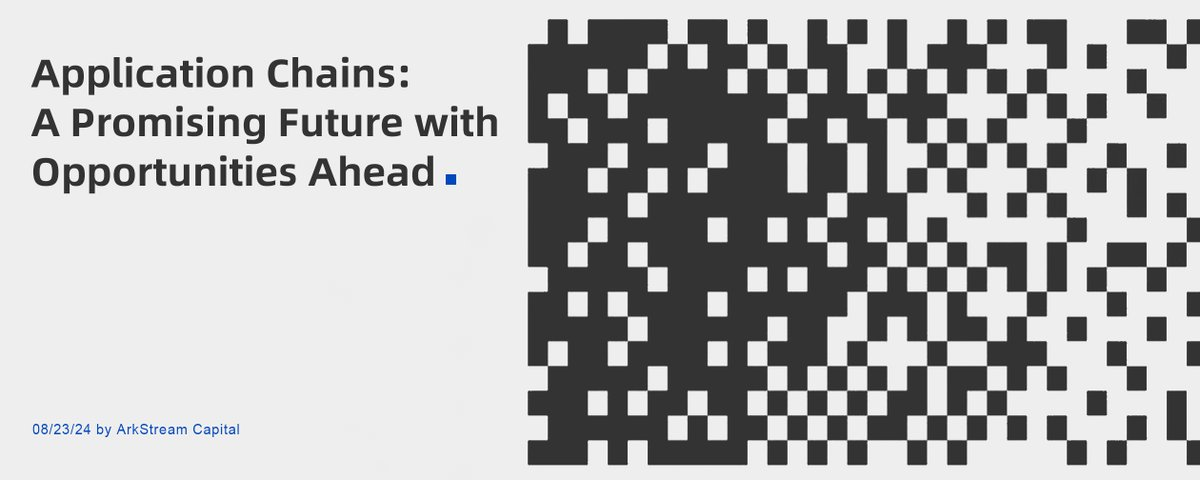
Key Points Summary
The development of application chains is influenced by various factors, including the maturity of infrastructure, intensified competition for block space, and the increasing demand for customized token economic models.
Although decentralized applications (dApps) and application chains share similarities in their business models, their respective strengths and limitations are also apparent. If more emphasis is placed on cooperation with the ecosystem, dApps may be more suitable; while prioritizing autonomy and independence, application chains have the advantage.
The development of Cosmos and Polkadot is constrained by technical challenges, economic mechanism design, and the high threshold of application chains.
The core of application chain development lies in establishing application barriers, using low-cost transactions to promote high-frequency on-chain activities, and accumulating traffic and users. While technical support and enhancement are crucial, they are more like auxiliary factors rather than core elements.
In the future, application chains may solve the existing liquidity fragmentation and interoperability issues through aggregation layer, super chain, or chain abstraction technology.
Although the market capitalization or complete dilution valuation of application chains may increase, the real key lies in the quality of the applications themselves and user experience.
Inevitable Trend of Application Chains
In 2023 and 2024, more and more dApps announced their transformation into application chains. After analyzing the field of application chains, we found that these chains are mainly concentrated in areas such as DeFi, gaming, social, and artificial intelligence. We believe that the development of application chains has become an inevitable trend, driven by the maturity of modular technology, widespread adoption of general Rollup Layer 2 networks, the increase in the number of RaaS platforms and the improvement of their services, as well as the competitive pressure of dApps in block space and the demand for customized token economies.
However, we believe that the upgrade of dApps to application chains will not immediately translate into high valuations at the infrastructure level, as dApps and application chains are more of a technical choice rather than a decisive factor for success. The advantage of application chains lies in promoting higher-frequency on-chain transactions through low-cost transactions, using data accumulation to enhance user experience, strengthen user stickiness, and achieve network effects. Therefore, the core of application chain development still lies in its unique application barriers and traffic.
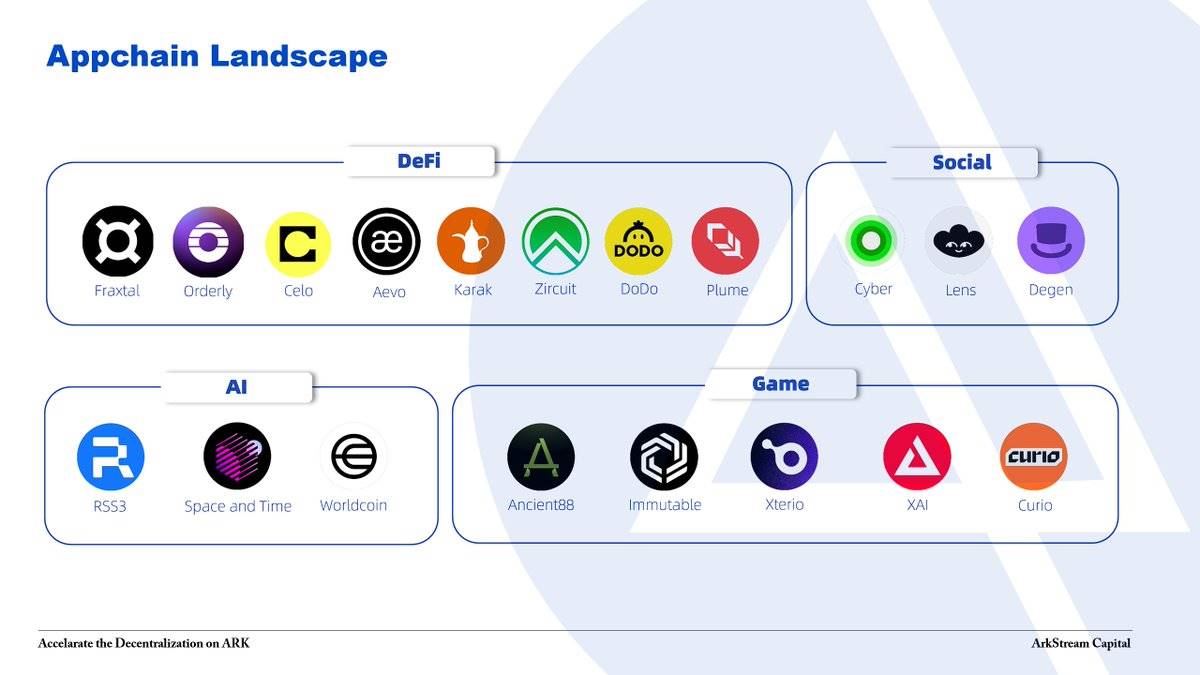
Exploring the Origin of Application Chains
When discussing the origin of application chains, we cannot fail to mention the pioneering Cosmos project. Cosmos is known for its modular and pluggable design, which separates the virtual machine from the consensus engine, allowing developers to choose the virtual machine framework and customize key consensus engine parameters, such as the number of validators and TPS. This design allows various applications to exist as independent chains, demonstrating flexibility and the unique advantage of sovereignty. These innovative concepts have made Cosmos a significant contributor to the exploration and practice of application chains, laying a solid foundation for this field.
By reviewing the application chain ecosystem of Cosmos on Mintscan, we found that many well-known and mature application chains, such as dYdX, Osmosis, Fetch AI, Band, and Stride, are built based on the Cosmos framework. However, the overall growth of Cosmos-based application chains has not been sustained, and the number of new chains has not significantly increased. We believe that this is mainly because Cosmos grants too much sovereignty to application chains, and before the introduction of Atom 2.0's ICS solution, the high startup and maintenance costs hindered their security.

Typically, building application chains based on Cosmos requires a team familiar with the Cosmos SDK and Tendermint consensus engine, which adds additional technical burden to teams primarily focused on application development. In addition, even if a project team can assemble enough technical personnel, the launch logic of most Cosmos-based chains involves airdropping tokens to attract initial validators and ensure network security, while high inflation rates incentivize validators to maintain security. However, this approach accelerates token devaluation, weakens the network's value, and makes it more difficult for application chains to establish themselves in the market.
With the introduction of Atom 2.0's ICS solution, the concept of application chains will evolve into a permissionless consumer chain model, reducing the cost of protecting consumer chains. However, this voting model managed by DAO may face similar inefficiencies to Polkadot's parallel chain auction mechanism. In addition, the lack of activity in chains, developer documentation resources, and community culture weakens the attractiveness of Cosmos to new application chains. For example, the Cosmos Hub stopped block production earlier this year, and limited developer documentation during the 2023 inscription boom affected its attractiveness, coupled with the "small circle" policy of the Interchain Foundation, making it more difficult for new projects to join.
Catalysts for New Application Chains
Early Cosmos application chains can be seen as chain-centric applications, emphasizing the sovereignty of the chain, while new application chains are more application-centric, focusing on application development. The rise of these new chains is driven by several factors, including the popularization of modular blockchain concepts, the maturity and widespread application of general Rollup Layer 2, the development of interoperability and liquidity aggregation layers, and the rise of RaaS platforms.
Optimism's successful launch in 2022 marked the realization of modular blockchain theory, demonstrating how Rollup efficiently scales Ethereum and encouraging exploration of Layer 2 solutions. Building on this, Optimism borrowed concepts from Cosmos, introducing the OP Stack concept, which has been widely used in projects such as Worldcoin and Base, further attracting industry attention. Other Rollup solutions have also introduced similar concepts, such as Arbitrum Orbits, Polygon CDK, StarkWare Appchains, and zkSync Hyperchains. Therefore, application chains have become a new way for dApps to implement business logic, with the main challenges shifting to technical choices, business design, and operational maintenance.

Implementing Rollup solutions typically requires choosing the appropriate execution framework, such as OP Stack or Arbitrum Orbits. OP Stack is an evolving Rollup framework that needs continuous upgrades to support new features of Ethereum, such as Cancun's Blob feature, while also supporting emerging features such as alternative data availability. To simplify the development process of application chains, the following steps are typically followed:
Technical Choice: Evaluate the features and advantages of different frameworks and choose the most suitable one.
Requirement Design: Design the application chain according to the customization capabilities of the framework.
Operation and Maintenance: Complete deployment, testing, launch, and continuous maintenance.
Choosing and implementing the appropriate Rollup framework is not easy, especially as making changes after deployment may become more complex. This is why RaaS platforms such as Altlayer, Caldera, and Conduit have emerged. These platforms, similar to SaaS, focus on Rollup solutions, helping dApps quickly select different frameworks, simplify the complex steps of application chain development, provide customized core features, and support maintenance and optimization after deployment.
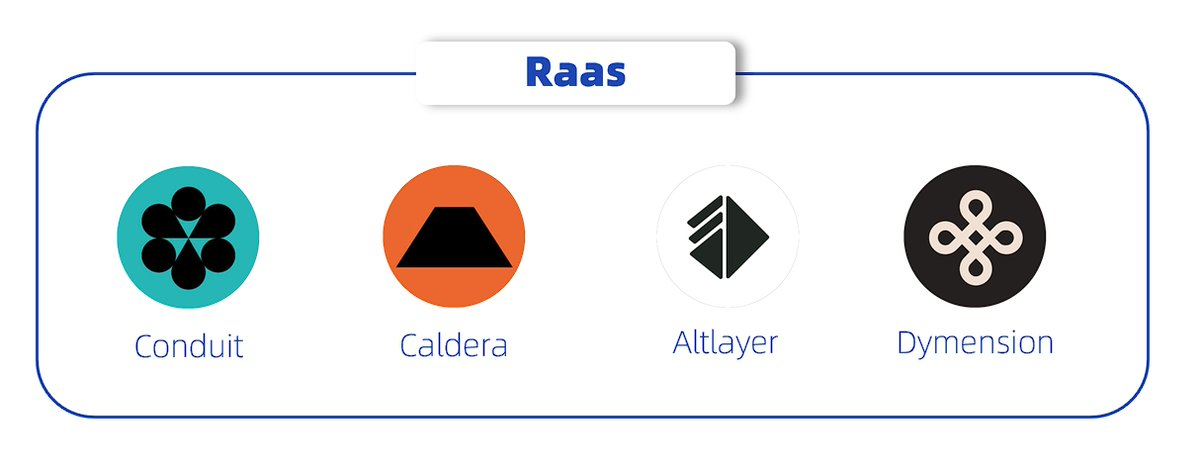
At the same time, the infrastructure and related features of application chains are rapidly advancing, introducing new protocols and features such as alternative data availability, including Celestia, EigenDA, and NearDA, to reduce costs and increase throughput. RaaS platforms also introduce integrated support for custom gas tokens and native account abstraction. As Rollup-based application chains become more popular, the issues of liquidity fragmentation and interoperability become more apparent, driving the emergence of solutions such as Optimism's super chain, Polygon's AggLayer, Caldera's Metalayer, and zkSync's Elastic Chain, aimed at improving interoperability and liquidity aggregation between application chains.
Although these catalysts lower the barriers to entry for application chains, the challenges in the primary and secondary markets are intensifying the exploration of paths for breakthroughs for dApps. According to data from CMC and Rootdata, among the top 100 projects in the secondary market, apart from meme tokens driven by the community and culture, there are only a few pure application projects such as Uniswap, LDO, Aave, Ondo, Jupiter, and Ethena, while most projects still belong to infrastructure. This phenomenon implicitly indicates that infrastructure holds a higher position than applications in the crypto industry.
In the primary market, the amount of application financing is also much lower than that of infrastructure. We believe that this is partly due to the less mature and user-friendly UI/UX design of Web3 applications compared to Web2, and the lack of true paradigm innovation in applications. Nevertheless, we believe that the potential of application chains has not been fully tapped and may become an important breakthrough for the development of Web3 in the future. Currently, well-known application chain projects such as IMX, Cyberconnect, Project Galaxy, and Worldcoin are demonstrating the huge potential of application chains.
Pros and Cons of New Application Chains
In the field of technology and innovation, the term "silver bullet" is often used to describe a perfect solution that solves all problems. However, in reality, no technology can solve all problems at once. Similarly, new application chains are not a universal or perfect solution. Here is our analysis of their advantages and disadvantages:
Advantages
Modular Design: Application chains typically adopt a modular design, allowing developers to customize settlement mechanisms, data availability, and other infrastructure components according to specific needs.
Performance Optimization: Many new application chains introduce alternative data availability solutions to reduce costs and increase throughput.
Enhanced Value Capture: Features such as custom gas tokens and account abstraction make application development more flexible and support more complex business and token models.
Disadvantages
Liquidity Fragmentation: New application chains may face the issue of liquidity fragmentation, leading to uneven resource allocation.
Interoperability and Composability Issues: Application chains lack the composability and interoperability convenience previously enjoyed on public chains, limiting their development potential.
Increased Complexity: Compared to traditional dApps, new application chains introduce higher complexity, especially in design and implementation, which may require more technical resources and support.
Core Considerations for Deciding on Application Chains
From the perspective of project teams, when deciding whether to upgrade or iterate to application chains, it is advisable to follow the following principles:
1. Dependency on Existing Public Chain Features: If your application heavily relies on other dApps on the public chain, such as liquidity or product functionality, it is advisable to continue using the existing dApp solution.
2. Need for Custom Features: If the current application cannot support key business requirements at the protocol level, such as account abstraction or specific onboarding mechanisms (such as revenue sharing), and these features are crucial for business operations, it is advisable to consider transitioning to application chains.
3. Cost Sensitivity: If end users are very sensitive to blockchain space resources, or wish to reduce losses such as MEV, then application chains may be a better choice. Additionally, if the application involves high-frequency trading, application chains can provide higher resource efficiency and lower transaction costs.
Building Moats and Development Paths for Application Chains
We believe that the moat of application chains always lies in their application business. The key to success lies in deeply identifying market pain points and establishing Product-Market Fit (PMF). Narratives that rely solely on chain infrastructure are akin to "looking for nails with a hammer," and are not an effective strategy for building moats.
In the current wave of new application chains, the focus should be on building transparent and low-cost applications, identifying market needs, addressing product pain points, perfecting and safeguarding products, while accumulating a large amount of user data, developing a cash-flow positive business model. This will create strong user stickiness and network effects.
An overly high-profile approach may not be suitable for application chains. At least until the core product is perfected and user growth data is fully established, the focus should be on product development, with marketing as a secondary priority. The accumulation of user data, cultivation of user habits, and iteration of product features are not achieved overnight, therefore, a steady and cautious approach is more suitable. Application chains should first establish core features, even irreplaceable features. On this basis, new features and product lines can be developed. Even if new features receive a lukewarm response, a defensive strategy can be adopted to abandon them. When upgrading and iterating application chains, multiple deep integrations with existing application features can be carried out.
For example, the well-known portfolio visualization and asset management platform Debank has long been tracking and observing assets, transaction history, and dApp positions in ETH and EVM-based wallet addresses, and has iterated many features based on this. Although some of Debank's less well-known features, such as notifications, bookmarks, and greetings, have not weakened its core asset management capabilities, they still exist. The paid features of Debank also reflect its attention to detail, providing diverse and refined payment options and integrated package optimizations, offering thoughtful choices for users. The overall performance of these features, in synergy with Debank's other product line Rabby Wallet, is strong. Although Debank is driving the development of Debank Chain based on OP Stack, users have not felt a significant difference, indicating that Debank's application chain has effectively established its core moat and provides valuable insights for the development path of other application chains.
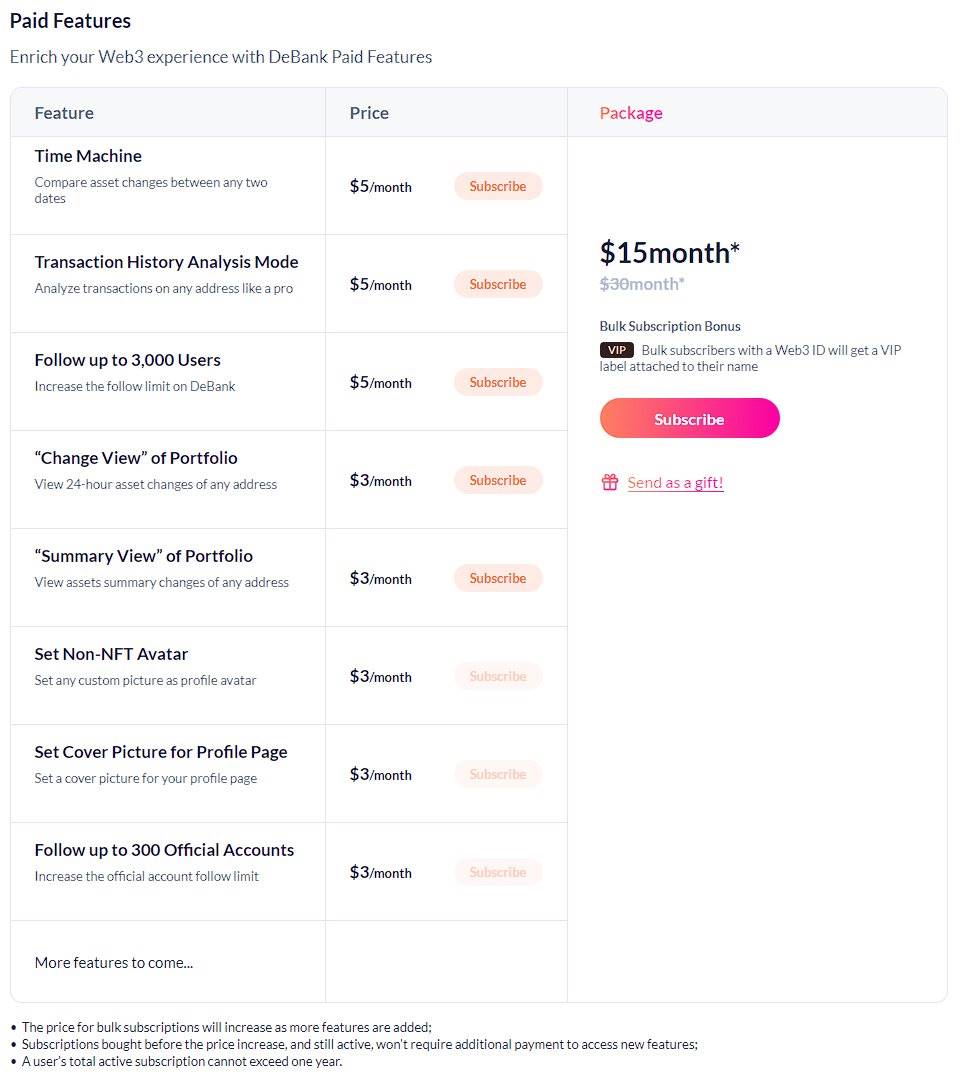

Designing Token Models for Application Chains
When building the token economic model for application chains, we advocate for an "organic" approach. The core of this strategy is to minimize human intervention as much as possible, avoid relying on short-term incentives. Our goal is to align the circulation and value growth of tokens with the expansion of the application itself and the growth of the user base. In this way, the token economy can synchronize with the long-term development of the application and the actual needs of users, achieving sustainable growth.
In the early stages of an application, tokens can be an effective tool to attract users and achieve "cold start." However, to ensure that these initial users are not only attracted but also converted into long-term users, the key lies in designing an efficient and attractive mechanism. This mechanism should be based on a clear positioning of the application product, a deep understanding of user needs and preferences, and a comprehensive understanding of the business background. Additionally, the core value of the token must be clearly defined to ensure that users can recognize its long-term potential and benefits. Through such a strategy, tokens can not only attract users but also encourage them to continue participating and deeply using the product.
The growth in the number of token holders should be consistent with the expansion of the user base to ensure the healthy development of the token economy. We should avoid adopting overly aggressive token distribution strategies and instead focus on achieving a model of sustainable growth. This requires us to fully consider the current market liquidity and potential changes, while ensuring that the token economic model is closely linked to the vision of the application. Additionally, NFTs, as a new type of reserve asset, can be innovatively combined to provide users with diverse usage scenarios, thereby enhancing the attractiveness and market competitiveness of the token.
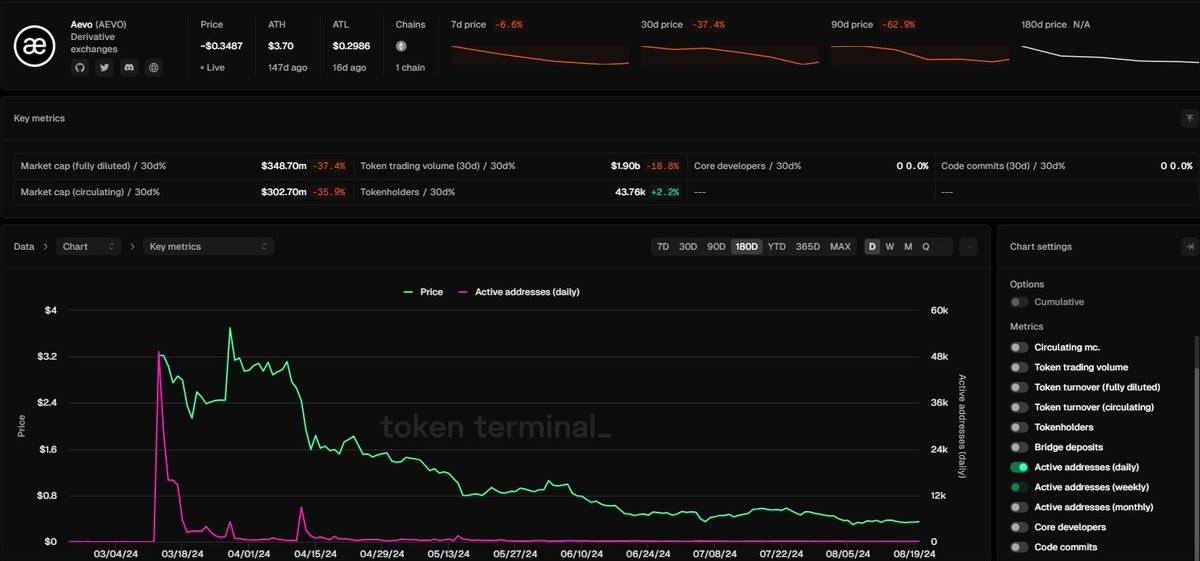
Learning from failed cases is the key to avoiding mistakes when designing application chain tokens.
For example, Aevo is a new token listed on Binance in the past six months. It has not been affected by a lack of liquidity. After attracting a large number of early users through airdrops, Aevo gained a foothold in the pre-trading field. Unfortunately, Aevo's overly aggressive and unrestricted token design ultimately harmed the core growth metrics of the product. Currently, Aevo shows stagnation in key metrics such as token holder growth, daily trading activity, and basic market depth in pre-trading. Therefore, to build a token economic model that is both attractive to users and sustainable in the long term, we advocate for an organic growth strategy based on intrinsic value and user needs, driving natural growth of the token and expansion of the application.
Overview of Prominent Application Chain Projects
Let's delve into the analysis of some prominent application chain projects in the market.
Cyber is a heavily staked Ethereum Layer 2 network aimed at achieving mass adoption in the social field. Its core features include native account abstraction, decentralized storage (CyberDB), and decentralized ranking supported by the Enshrined Social Graph Protocol of CyberGraph and CyberAccount. Its core application product, Link3, allows verified Web3 companies and professionals to create reusable data on-chain, which can be integrated and utilized by other applications.
XAI is a Layer 3 network compatible with EVM, developed by Offchain Labs using Arbitrum technology, specifically for game development. XAI allows players to own and trade in-game items without using a cryptocurrency wallet, while network node operators participate in governance and receive corresponding rewards, creating an open and real economic experience for traditional players.
MyShell AI is an innovative platform targeting AI intelligent agent creators, as well as connecting users, creators, and open-source AI researchers in the consumer AI layer. Users can quickly customize intelligent agents with personalized voice styles and features using MyShell's proprietary text-to-speech technology and AutoPrompt tool. For intelligent agent creators, the platform offers efficient intelligent agent creation, monetization options, and the ability to profit from their intelligent agents.
GM Network aims to be a leader in the consumer AIoT field. It combines advanced AltLayer technology, EigenDA, and OP Stack to create a decentralized DePIN. GM Network's goal is to establish a large incentive and communication platform, bridging the gap between the virtual and real world by integrating AI and DePIN/IoT technology, thereby driving widespread application of AI on the consumer end.
Investment Analysis Framework
When conducting investment analysis, we use the following framework to ensure a comprehensive and in-depth assessment of applications:
1. Industry Understanding and Market Positioning: Deep understanding of mechanisms and practices in the crypto field, identifying market pain points, and proposing innovative application solutions.
2. Target Customer Base: Applications should target a large and potential user base, as this directly impacts their market capital ceiling.
3. Product Delivery and Iteration Speed: Compared to infrastructure, applications require strong product delivery capabilities and rapid iteration speed to ensure continuous optimization and innovation of features.
4. User Retention and Business Model: Applications must establish strong user retention capabilities and achieve sustainable growth through GMV growth and a matching business model.
By following this framework, we can systematically assess the overall strength and market potential of projects, providing a solid foundation for investment decisions.
Outlook
We are optimistic about the development of application chains. This optimism stems from the potential of application chains as core platforms for user activity, playing a crucial role in diverse fields such as social networks and gaming. In the future, these application chains will not only provide rich interactive experiences but also drive innovation and development in related industries through their unique technological advantages.
Notes
B2B and B2C application business models have their own characteristics, but their integration with application chain technology is similar. This article does not strictly distinguish between the two, but focuses on how they use application chain technology to achieve business goals and growth.
The main difference between Layer 3 and Layer 2 application chains is that Layer 3 uses a specific Layer 2 as the settlement and data availability layer, so structurally it is not much different from Layer 2.
Solana has not officially supported the development of Layer 2 yet, and its focus is still on building a high-performance Solana public chain. For Layer 2 or application chains on Solana, their integration methods are similar to Ethereum, with the main difference being the execution framework and data availability layer.
Although the current state of Layer 2 may seem relatively quiet, the real problem lies in some Layer 2 chains overly relying on the expected on-chain prosperity brought about by airdrops, without fully operating and maintaining the ecosystem. According to data from Defillama, Layer 2 chains such as Arbitrum and Base are still highly active.
The revenue sharing models between application chains and RaaS platforms vary, such as fixed fees or sorter revenue distribution. Application chains of different scales can choose the appropriate revenue sharing model based on their business situation.
免责声明:本文章仅代表作者个人观点,不代表本平台的立场和观点。本文章仅供信息分享,不构成对任何人的任何投资建议。用户与作者之间的任何争议,与本平台无关。如网页中刊载的文章或图片涉及侵权,请提供相关的权利证明和身份证明发送邮件到support@aicoin.com,本平台相关工作人员将会进行核查。




